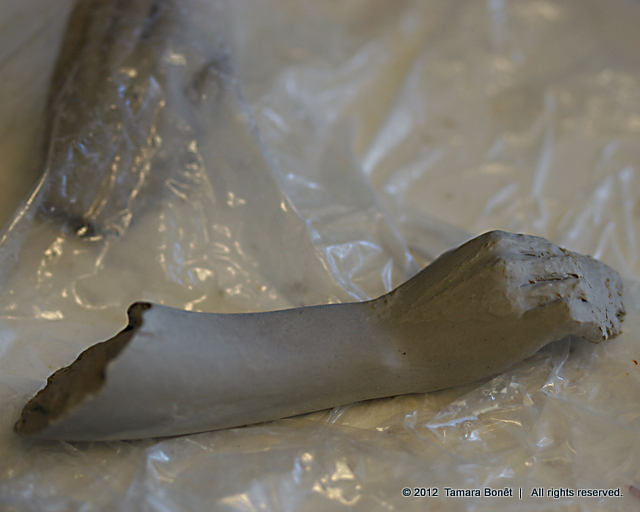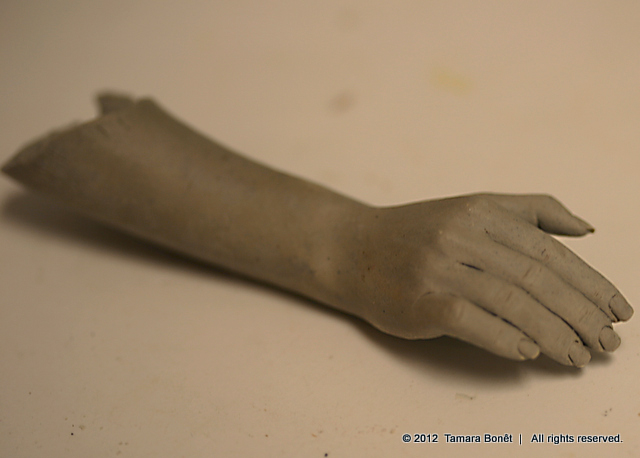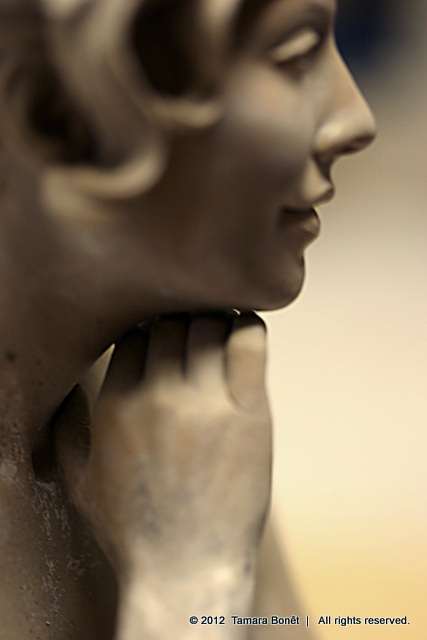

Garden Reverie Sculpture- #7
QCFA Blog Post #7 – Garden Reverie
Today I want to show how this arm and hand was more difficult to sculpt than the other hand. Lining up her hand in the right position under her chin was part of the difficulty.
(See Garden Reverie’s finished clay pics and promotion and bronze photos)
Here’s the rough sketch close-up photo to show how the hand first looked.
Positioning the pinky just right adds to the feminine flair. Between that and feminine fingernails, I’m a happy camper as far at the hands are concerned. ![]()
You can see the rough texture of the clay; the final pics show smooth skin. This was brought about, in part, by brushing some liquid slip on the surface (slip is made up with no-grog [grit] clay). Then I used various tools and techniques to further refine and smooth the skin. Because I want a polished smooth skin bronze sculpture, the more I can do in the clay process the better, and will save on foundry labor and costs.
Once again, I remove part of an arm and leave registration marks. The jagged edge looks a bit morbid, but the uneven edge actually helps with lining up the arm once I reattach it. I took the arm off and on many, many times before I had everything in place. And then…. I cut it off again (but in a different place) for the mold process.
Since this is waterbased clay, the hands will dry out quickly, so they have to be kept under plastic as often as possible to slow down the drying.
Her four fingers needed to touch right under her chin and the thumb had to touch at the right spot on the neck. This took a lot of coordinating and is difficult to do in waterbased clay where the fingers are delicate and can be broken off very easily. There are features to waterbased clay I love and these outweigh the hardships I encounter.
If her hand was too wide open, it looked like she was waving at you, which wasn’t the right effect. By taking photos to help me “see” better, I was able to get the right gesture for the hand. Comparing before and after photos is my number one tool for judging improvements.
Every day I took pics at the end (many times during working as well) and in the morning, while having breakfast, I reviewed those photos, comparing and observing what I liked and what I wanted to work on. Many times I’d go into Photoshop and make mock-up alterations to see how I liked it, before sculpting on the actual figure.
Next I’ll share pics and comments about sculpting her legs. Thanks for following along.
~Tamara









Thank you for the insights on your approach to solving the hand under the chin features…
Your welcome!
Thank you for sharing.
Would it be revealing trade secrets if you expand on
” I used various tools and techniques to further refine and smooth the skin”?
Thanks for the very detailed description!
Thank you very much for sharing such precious information.
My eyes never get tired of looking at this elegant masterpiece.
Is she solid clay? Cause her hand seems solid (doesn’t have a core of paper, etc), I was wondering how you avoid the risk of possible air bulbs which can explode and damage a statue during the firing process?
Roy, -No secrets, the techniques are the same ones most clay artists use and for the sake of time I just didn’t go into the basics of smoothing clay with grog.
Mary, What a nice comment. Thank you! she is solid in her arms and legs but her torso is hollow. Since she isn’t that big, she will fire okay with solid limbs. Clay with grog can have up to 1″ thickness and be alright in firing.
Tamara, beside being incredibly talented, you’re also very kind and generous. Thank you very much for your kind reply and the valuable explanations.
You painted her with slip to smooth out the clay! That’s something I’ll remember the next time I try to do a figurative piece. My small lady sculpture had a big piece of grog RIGHT AT THE TIP OF HER NOSE! I finally got annoyed enough to dig it out and put more clay there, then had to re-sculpt the nose. If I’d thought to use slip, I might not have had the problem. Then again, slip might just muddy the detail in something as small as my lady sculpture, right? (She’s about 6″ tall). I can’t imagine removing the hands from something as small as my lady. How tall is your piece again? Thanks so much for sharing! I love the grace of her hand – really excellent job (as usual)!
Hi Lynda,
I’d do the same thing, remove the grog and fill in with some clay. Most of the time I don’t need to paint the skin with slip because as I’m working, I wick up to the surface the smooth slip. It’s much like working with concrete and how the gravel gets pushed below and the cream comes to the top. But you have to work it while in the workable stage. If you get pass that point, then you have gravel on the surface and no cream to go after. That’s sort of what happened with my piece. It had a lot of grog on the surface and not enough creamy slip to wick up.
Garden Reverie will be with her granite base 16 1/2″ (15 1/4″ without base).